|
| |
Indo-American Arts Council
In collaboration with Pace University
presents
Erasing Borders Festival of Indian Dance Indoors |
At Pace University Studios, 140 William St. (enter at 96 Fulton St), NYC.
September 5th-6th 2014
Click here for Map |
| |
| September 6th PROGRAM: 10am - 5pm |
Festival Pass: $55 general admission $50 IAAC members
Includes tickets to all Erasing Borders Festival of Indian dance events from Sep 5-6, 2014
 |
| 10 - 10:30 am |
Registration |
| |
|
| 10:30 - 11:30 am |
Session # 1: |
| |
Studio 1: Workshop and Master Class by Sattriya Dance Company and Anita Sharma |
| |
Studio 2: Workshop and Master Class by Mitul Sengupta |
| |
Tickets: $15 general admission; $10 IAAC members
 |
| |
|
| 11:45 am - 12:45 pm |
Session # 2: |
| |
"Contemporary Process from traditional language" by Delhi Dance Theater |
| |
Tickets: $15 general admission; $10 IAAC members
 |
| |
|
| 1:00 - 2:00 pm |
Lunch |
| |
|
| 2:15 - 3:15 pm |
Session # 3: Film Clip Showing & Discussion: "Capturing Your Dance on Camera"
|
| |
A discussion on strategies for capturing dance-works on camera, with reference to excerpts from
|
| |
Sumantra Ghosal's UNSEEN SQUENCE (on Malavika Sarukkai); Sankalp Meshram's LASYA KAVYA (on Alarmel Vali); Sheetal Gandhi's site-specific work I AM YOU (with Meena Murugesan)
Moderator: Rajika Puri |
| |
Tickets: $15 general admission; $10 IAAC members
 |
| |
|
| 3:30 pm - 4:30 pm |
Session #4 Panel discussion |
| |
Panel on Dance and religion: Collisions & convergences of transcendance in performing global Indian classical dance. |
| |
When we see Indian classical dances, we expect that spirituality must somehow rendered visible and audible via representations/descriptions, of Divine Beings, or via rituals, and stories. It must be very particular to local shared experience of religion and also be uplifting and beautiful. It is not about exploring darkness, but about light. The panelists will share their diverse perspectives on the demand for transcendence that is embedded in the structures of performing, and practicing Indian classical dance forms. |
| |
Speakers: Dr. Francis Barboza on Christian themes and Bharatanatyam;
Mesma Belsare on Philosophical issues from Bhakti/religious issues; Ammr Vandal on Islamic themes & Kathak. |
| |
Moderator: Uttara Coorlawala |
| |
Tickets: $15 general admission; $10 IAAC members
 |
| |
Festival Pass: $55 general admission $50 IAAC members
Includes tickets to all Erasing Borders Festival of Indian dance events from Sep 5-6, 2014
 |
| |
|
| |
Studio 1: Workshop and Master Class by Sattriya Dance Company and Anita Sharma |
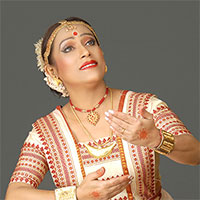 |
The workshop will give attendees a brief background on Sattriya, its history and its nuances. They will be introduced to 10 mati akhoras or ground exercises, which are used to prepare the body of a dancer. They will also be introduced to 10 hastas and 5 basic feet movements. They will end the program by teaching a Krishna Vandana.
The Sattriya dance form has remained a living tradition in Assam's Vaishnava monasteries, known as sattras, for over 500 years now. It was originally practised by celibate monks in the form of mythological dance-dramas. Thesedance-dramas were, in the main, written and directed by the Assamese Vaishnava saint and social reformer Sankaradeva, and by his principal disciple Madhavadeva. They were mostly composed during the 16th century In the second half of the20th century, Sattriya Nritya moved from the sanctum of Assam's sattras/monasteries to the metropolitan stage. Once the domain of celibate male monks, it is now performed by male as well as female dancers. The sattras had observed and maintained certain rigid disciplines and austerities within their walls and, until the first half of the 20th century, this dance style was performed in a highly ritualistic manner by male dancers alone. The classical rigidity, the strict adherence to certainprinciples, and the non-engagement of academic research on the dance form all contributed to the delayed recognition and acceptance of Sattriya Nritya as one of the eight classical dance forms of India.
|
| |
|
| |
Studio 2: Workshop and Master Class by Mitul Sengupta |
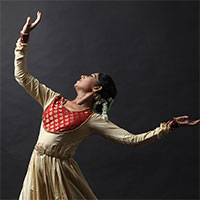 |
Kathak Exponent, Mitul Sengupta who has also studied Laban Movement Analysis will hold a workshop applying the basic concepts ofLaban Movement: time, space, and effort to the universal language found in all Indian classical dance forms.
She will also demonstrate and teach 'gat chaals' which are various types of gaits found in the dance form, Kathak.
Laban Movement Analysis (LMA) is a method and language for describing, visualizing, interpreting and documenting all varieties of human movement. It is one type of Laban Movement Study, originating from the work of Rudolf Laban and developed and extended by Lisa Ullmann, Irmgard Bartenieff, Warren Lamb and many others. In addition many derived practices have developed with great emphasis on LMA methods.
Also known as Laban/Bartenieff Movement Analysis, it uses a multidisciplinary approach, incorporating contributions from anatomy, kinesiology, psychology, Labanotation and many other fields. It is used as a tool by dancers, actors, musicians, athletes, physical and occupational therapists, psychotherapy, peace studies, anthropology, business consulting, leadership development, health & wellness and is one of the most widely used systems of human movement analysis today. |
| |
|
| |
"Contemporary Process from traditional language" by Delhi Dance Theater |
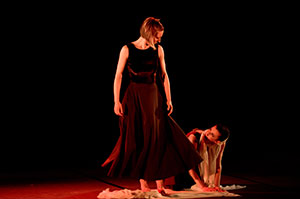 |
Emily McLoughlin and Leah Raphael Curtis will speak about their working process and then have a practical demonstration of the way they work and deconstruct a phrase of the duet they will have performed at the indoor concert on Sep 5. |
| |
|
| |
Session # 3: Film Clip Showing & Discussion: "Capturing Your Dance on Camera"
|
| |
A discussion on strategies for capturing dance-works on camera, with reference to excerpts from |
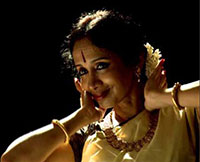 |
Lasya Kavya - film about Alarmel Valli
Lasya Kayva - a film on iconic Bharatanatyam dancer and choreographer Alarmel Valli. By director Sankalp Meshram, explores the intellectual, emotional and spiritual contexts within which she performs. Adiverse range of performance, rehearsal, choreography and teaching sequences, are interwoven with interviews and archival footage of the dancer, with herdance and music gurus, offering glimpses into core ideas and complex facets of her art. |
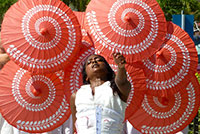 |
Sheeta Gandhi’s site specific work in LA titled I am You
This site-specific performance was originally created for the Annenberg Community Beach House in Santa Monica, CA as a part of their Artist Residency program. The show is built for two dancers and non-performer volunteers from the local community who are integrated into the process and performance of the work. I Am You explores the nature of duality - of the complex relationship between the soul and the personality, or the perception of the “inner” and “outer” person. I Am You explores the concept of tawhid - union with the beloved (the primal root) from which/whom one has been cut off and become aloof - and the longing and desire torestore it. The work incorporates dance, text and live singing, featuring the timeless poetry of the Persian mystic poet, Rumi and commentary on motivational talk shows and other self-improvement scenarios. |
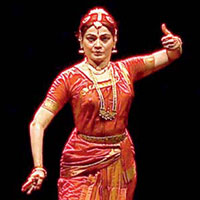 |
Unseen Sequence - film based on Malavika Sarukkai
Post-screening discussion with Moderator: Rajika Puri
In Malavika Sarukkai - an artist rooted in tradition but with a uniquely contemporary sensibility - one of India's most profound classical arts, Bharatanatyam, is being re-interpreted, renewed, invigorated.The film is not simply about Malavika Sarukkai; it deliberates the valuable connections and departures that the artist makes from a hallowed and, often, unforgiving tradition.Today, even as she impresses her footprint on the world stage as a celebrated Bharatanatyam dancer, Malavika finds herself making increasingly personal choices about how she wishes to lead that life. It is this co-existence of consummate expression with a deeper, spiritual quest that makes her dance so exciting.
Sumantra Ghosal | Director
Post-screening discussion with Moderator: Rajika Puri |
| |
|
| |
Session #4 Panel discussion |
| |
Panel on Dance and religion: Collisions & convergences of transcendance in performing global Indian classical dance. |
| |
|
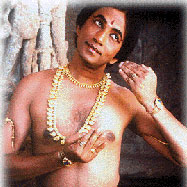 |
Speakers: Dr. Francis Barboza (http://www.drbarboza.com) on Christian themes and Bharatanatyam; Mesma Belsare on Philosophical issues from Bhakti/religious issues; Ammr Vandal on Islamic themes & Kathak.
Moderator: Uttara Coorlawala |
| |
|
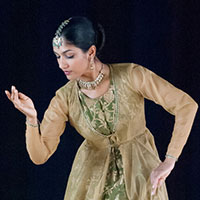 |
Ammr Vandal has been a member of the Parul Shah Dance Company for the last ten years. She began learning Kathak in her home town of Lahore, Pakistan under the tutelage of the late Maharaj Ghulam Hussain and Nahid Siddiqui. After an extended break, in which she pursued her college education in Hong Kong and the US, she resumed her training in New York City under Parul Shah, a leading disciple of Padmashree Kumudini Lakhia. The repertoire of the company includes traditional kathak solo and group pieces along with contemporary dance pieces. Ammr has been featured in numerous performances including Yale Center for British Art, Peabody Essex Museum, Jacob’s Pillow: Inside/out series, the Lincoln Center for Performing Arts: EnGendered Arts festival, Solar One: Sun to Stars festival, City Center in New York: Fall for Dance Festival, Rosswell Cultural Center Atlanta: Parul Shah & Co., City Center in New York: Career Transitions for Dancers, Tribeca Performing Arts Center: Tradition Unbound , Brooklyn Museum of Art: Parul Shah & Co. as well several other educational and demonstrative performances.
Ammr is currently based in New York where she is continuing her training under Parul Shah as a member of the Parul Shah Dance Company. Along with pursuing her passion for Kathak, she works as an Architect allowing for an undeniable influence of both spatial art forms on each other |
| |
Festival Pass: $55 general admission $50 IAAC members
Includes tickets to all Erasing Borders Festival of Indian dance events from Sep 5-6, 2014
 |
| |
|
|
|
|

